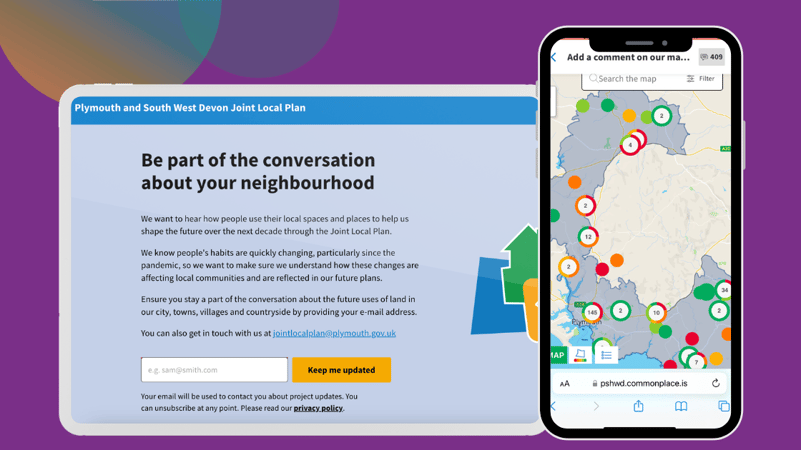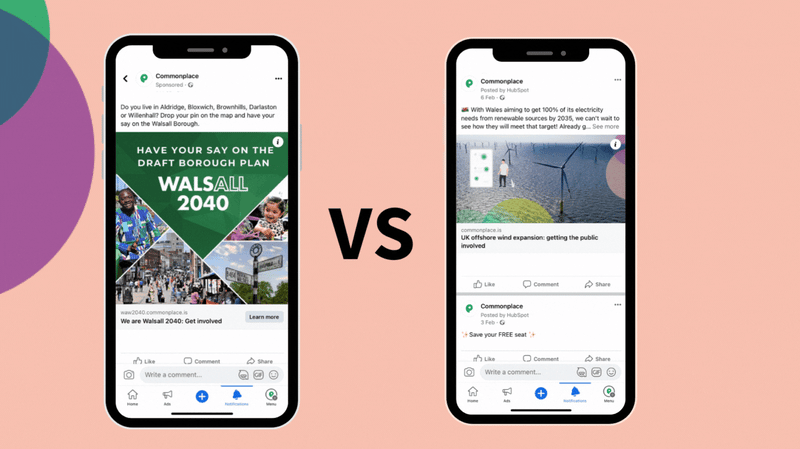8 tips on how to encourage citizen participation

By Charlotte Cooper | 25/11/23 09:00
5 min read
Active citizen participation is one of the most important parts of any engagement project. It’s the local people that know the ins and outs of where they live and will definitely want their voices heard when it comes to changes and improvements. So how do you get people more involved?
When penning any kind of citizen participation plan, be aware that it takes so much more than a functional website and the occasional email. Willing positive engagement needs time, work and trust. Things that can’t be created overnight - no matter how hard you try.
For your engagement project to be a success, you need a well-thought-out communications strategy to get people interested at a local level. Communities don’t only want to know what this project will entail, but also that they are a key part of the decision-making process.
At Commonplace, we’re all about community engagement and encouraging authorities and citizens to work collaboratively. So sit back, relax, and enjoy our top eight tips on how to encourage active citizen participation.
1. Start with your citizen engagement platform

It's time to create an online community.
The last few years have proven that digital is the way forward. The wake of the pandemic has left a wealth of tools for connecting and communicating and this includes how authorities are now talking to their communities. Having an online hub is an easy way to outline your plan, post updates and gather insights from the local citizens.
A community heatmap also makes it simple for people to leave their opinions on specific areas. Since it’s online, they can share their ideas 24/7 and easily see what others in their community think as well. It’s perfect for people with busy schedules and for those in more rural areas who might not be able to make it to local town hall meetings. (You don’t even have to leave the comfort of your own home if you don’t want to!)
Don’t forget mobile optimisation as well. It's predicted that by 2025, the UK population will grow to 68 million people and that 95% will own a smartphone* so having a website that works well on mobile is an absolute must.
2. Citizen Participation through email
Got a list of opt-in subscribers? Contact them directly through email. You can send a steady stream of updates to show that progress is being made and highlight exactly how the community’s participation has helped. This creates more transparency within your project and encourages people to continue engaging as well. Nothing demonstrates that people are being listened to more than showing exactly how they've bettered their neighbourhood.
3. Get social with social media

Did you know that over 90% of the UK is active on social media?** A huge portion of your audience could be waiting to see you pop up on their news feeds!
Posting regular organic content helps keep your existing followers up to date while a well-crafted paid campaign can reach those who haven’t seen your project yet. You can even target each ad by age, location, interest and more- perfect for hitting key demographics.
Keep in mind that people’s attention spans are short on social media. Moz revealed that the lifespan of a tweet is only 18 minutes and Facebook stated that the average attention span on their platform is 2.5 seconds. That’s not a lot of time to get people interested.
Luckily, we’ve got a full guide on how to grab attention and use organic and paid campaigns to encourage the most public participation possible. We can even help set you up with the real-time Commonplace dashboard making it easy to keep on top of all the data collected.
Read our quick paid social media guide here
Want to experience the Commonplace dashboard?
4. Don’t forget offline engagement tools
If you’ve been around our blog for more than 10 minutes, then you know that we always advocate for a blend of online and offline engagement tools. The internet may be the way forward, but the digital divide is still very real. Plus, adding offline activities into your plan helps you reach as wide an audience as possible and also gives you a physical street presence.
- Offline surveys: You can either hand out physical surveys or use a tablet to capture opinions at exhibitions, town hall meetings, or community feedback on location. Just make sure to ask the right questions.
- QR codes: To get people interested while on the street, our offline engagement pack helps you to generate designs so that you can set up QR codes on bus stops, billboards and more.
- In-person meetings: If you find that a sizeable portion of the community prefers to participate in person, there’s always a place for physical meetings as well. To make it as accessible as possible, consider recording it and posting later or streaming live so the rest of the community can easily see what was discussed.
Check out our full blended engagement strategy guide right here.
5. Use your existing contacts
If you’ve already got a list of existing contacts, you can drive more engagement by simply sending them a message. This could be via email, post or even an invitation to an event. Use the data you already have to see which engagement tactics worked for them and if any of their previous input could be useful for you now. For example, were their previous concerns addressed and how did you go about helping them? If they’ve had a positive experience once, they’re much more likely to get involved again.6. Post updates regularly
.png?width=801&name=News%20Feed%20-Header%20(3).png)
Whether it’s waiting for an RSVP or being stuck on hold for hours, no one likes to be left hanging. This is why it’s crucial to keep the community updated regularly on how your project is progressing. No news is too small or post too big- if people have engaged they’re going to want to know that their thoughts and efforts have actually achieved something. This could be through email, social media, directly on your project website or all of the above! With the Commonplace New Feed feature, you can easily write and publish updates directly to your community hub.
A good rule of thumb is to post around 1-2 times a week or any time there’s an urgent piece of news. If you pick particular days to post on, the community will know exactly when to come and look for updates as well.
7. Create a safe space for the community to participate
We don’t need to tell you that people are more likely to share when they feel comfortable. Commonplace as a platform was designed to empower communities and encourage citizen participation without fear of judgement. For example, other community members are able to upvote comments, but not downvote or leave their own comments on that pin. This way, others can clearly show if they like an idea and, if they don’t, can drop another comment and leave an alternative solution.
This helps prevent any negative discourse and encourages more people to leave a pin if they feel there are other ideas to be explored.
8. Citizen participation webinars
Since the beginning of the pandemic, you’ve probably been to your share of online events and have (hopefully) seen just how engaging they can be.
Hosting a webinar for your project opens the floor to all kinds of questions and conversations that can’t be had on your website. You can go into much more detail about certain aspects of your project which can be very helpful if people are confused or worried about it. You’re also talking directly to the community which helps create a more personal connection between planner and participant.
Record and upload your sessions later so those who couldn’t attend can catch up. This then becomes a permanent record of what was talked about so you keep your planning as transparent as possible- a surefire way to encourage more open citizen participation.
Ready to encourage citizen participation?
Organise a free personalised demo of the Commonplace platform.
.png)
